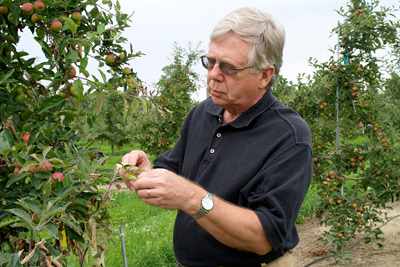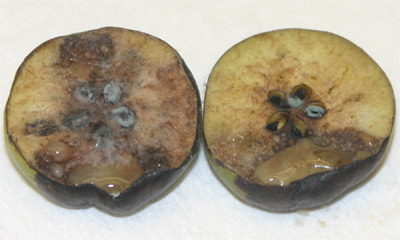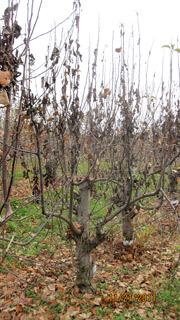Strep-resistant fire blight found in New York orchards
By Stacey Shackford

Cornell plant pathologists have issued a warning to New York apple and pear growers after discovering a strain of fire blight that is resistant to such traditional treatments as the antibiotic streptomycin.
For 50 years, the disease has been kept at bay using the antibiotic, but streptomycin-resistant strains of the disease were recently found in four locations in Wayne and Ontario counties.
"This is a serious situation that we need to manage effectively. The rapid identification of this outbreak positions us to implement a coordinated plan leading up to next year's growing season," said Herb Aldwinckle, professor of plant pathology and plant-microbe biology at Cornell's New York State Agricultural Experiment Station (NYSAES) in Geneva.

In coordination with colleagues at NYSAES and Cornell Cooperative Extension, Aldwinckle is developing guidelines growers can follow to reduce the threat. Upcoming sessions at the Fruit and Vegetable Expo and CCE Fruit Schools in several counties will also provide growers with opportunities to learn more about the outbreak and possible solutions.
Fire blight is caused by the bacterium Erwinia amylovora, earning its name from the scorched appearance of infected leaves and branches. Its symptoms include blackening of flowers and young leaves, resulting in crop loss and even death of trees.
Strep-resistant fire blight was first identified in California in 1971, and since then it has been found in Washington, Oregon, Missouri and southwest Michigan. Diseased nursery trees from Michigan were the source of a limited outbreak in New York in 2002. At that time, Aldwinckle and colleagues, in close collaboration with growers, ensured that all infected trees were destroyed and surrounding farms were checked.

That eradication appears to have been effective. "For the past 10 years, extension staff have sent in samples for routine surveillance, and we hadn't found it again," Aldwinckle said.
This current infection was first spotted in Wolcott, N.Y., where a persistent suspected fire blight infection evaded a streptomycin spray regime. Samples were immediately brought to Aldwinckle's lab.
Sampling was necessarily limited in late fall, so the full extent of the outbreak will be unclear until additional samples are studied, but the latest results indicate there are several outbreaks of strep-resistant fire blight in Wayne and Ontario counties.
Aldwinckle said the fact that one of the sites is a nursery does complicate the management plan. Fortunately, that nursery has a strict rogueing program -- in which infected plants are removed from the soil and destroyed -- that should minimize the chance of spread, he added.
However, Aldwinckle noted that some infections might not be immediately visible, so there's a possibility that a small number of trees with the strain were inadvertently shipped to growers.
He advises all growers to examine their trees carefully for any symptoms of fire blight that may develop after planting. These recommendations apply to all trees purchased, with particular attention for those from New York and Michigan nurseries, where strep-resistant fire blight is known to occur.
He is also exploring other ways to eradicate the blight.
"The antibiotic kasugamycin is as effective as streptomycin, and in some ways it is a more appropriate antibiotic because it is not used in human or veterinary medicine," said Aldwinckle. "Kerik Cox, an assistant professor of plant pathology at Cornell, is leading an application for a Section 18 emergency registration from the EPA [Environmental Protection Agency] for growers to use Kasumin [commercial kasugamycin] next spring."
Stacey Shackford is a staff writer at the College of Agriculture and Life Sciences.
Media Contact
Get Cornell news delivered right to your inbox.
Subscribe